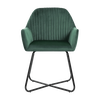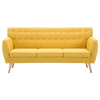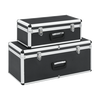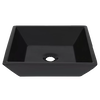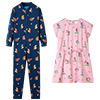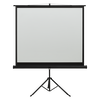Tents: A must-have on every camping trip
A tent is a must-have on any camping trip, offering shelter, comfort, and a sense of home in the great outdoors. Whether you're an experienced camper or planning your first outing, selecting the right tent is important. With a variety of options available, from lightweight backpacking tents to spacious family models, there is a tent to suit every need and preference.
What camping tent design should you choose?
Tents come in a variety of shapes and sizes, catering to different camping needs. The most common designs include A-frame, dome, tunnel, and cabin tents. Recently, new designs like instant tents, which use minimal components and are easy to set up, have gained popularity. Let's explore these various tent designs in detail.
-
Dome tents: Dome tents are spacious and easy to pitch, making them one of the most popular tent designs. They feature a stable, lightweight construction with two poles crossing at the highest point, providing ample headroom. While not the strongest option for extreme conditions, dome tents are ideal for non-extreme environments and often come in 2 to 3-person sizes.
-
Cabin tents: Cabin tents are ideal if you need a tent tall enough to stand up in. These tents have near-vertical walls that maximise peak height, offering plenty of space to move around. They are great for families or groups of four or more people. Though heavier, they are a great choice for car camping.
-
Tunnel tents: Tunnel tents are easy to set up and take down, making them ideal for daily pitching. They resemble dome tents but have a longer, cylindrical shape, often with separate storage areas. Tunnel tents provide ample headroom and livable space. This makes them ideal for families and larger groups. However, they rely on careful pitching with guy ropes and tent pegs for stability.
-
Geodesic tents: Geodesic tents combine the advantages of dome tents with enhanced stability. They feature multiple poles crossing each other, forming a structure of triangles that boosts overall strength. This makes them excellent for camping in extreme weather conditions and they can comfortably accommodate four people.
-
A-frame tents: A-frame tents, when pitched, resemble a capital "A." These tents were once popular for their simple design. Modern versions, made with lightweight fabrics and aluminium poles, are easy to pitch and stable, though they lack headroom.
-
Pop-up tents: Also known as instant tents, pop-up tents are quick and easy to set up, thanks to a spring mechanism that allows for instant installation. While not suitable for extreme weather, their ease of use makes them a convenient option for casual camping trips.
What is the right tent size to choose?
Tent sizes are categorised based on the number of people they can accommodate while lying next to each other, such as 1-person tents, 2-person tents, 3-person tents, and so on. If you plan to use an inflatable mattress instead of sleeping bags, consider this when selecting a tent size. Here are some pointers to help you choose the best tent size for your next adventure.
-
1-person tent: Ideal for solo campers or backpackers, a one-person tent is the smallest size available. With a floor area of approximately 1.5 – 2 square metres, it provides just enough space for one person and minimal luggage. These tents are lightweight and can be attached to a sturdy backpack, offering a comfortable place to sleep when needed.
-
2-person tent: A two-person tent comfortably fits two people of average height, with an average floor area of around three square metres. When selecting a 2-person tent, consider your height, frame, and the campground where you'll be pitching it. Key features to look for include easy transportation and quick setup.
-
3-person tent: With enough space to accommodate a small family, a three-person tent has an average floor area of around four square metres. It can fit a couple and a small child or family dog. While suitable for backpacking, it may require one person to carry the tent and another to carry the poles and accessories. These tents are easy to install and can typically be set up quickly.
-
4-person tent: Four-person tents offer ample space for most families and are great for longer trips. They have an average floor area of 5.5 – 6.5 square metres, comfortably fitting three adults and a small child or dog. Depending on your needs, choose a heavier or lighter model, especially if you'll be hiking during the day before setting up the tent.
-
5-person tent: Best for families of four or five, a five-person tent provides extra space for longer outdoor stays. With an average floor area of around seven square metres, these tents offer more headroom, allowing adults 1.80 – 2.10 metres tall to stand inside.
-
6-person tent: The six-person tent is the most popular size among families, with an average floor area of 8.5 – 9.5 square metres. It's important to note the difference between comfort rating and sleeping area capacity. While rated for six people, the comfort rating often accommodates four. These tents provide plenty of room for two adults and two children, along with gear.
-
8-person tent: An eight-person tent offers plenty of space, with a floor area of 11 – 12 square metres. It comfortably fits four people but can provide space for six if children or dogs are included. Consider these dimensions when selecting a campsite to ensure there's enough room to set up this large tent.
What camping tent material should you choose?
Surprisingly, many campers overlook the material when buying a tent, yet it significantly influences water resistance, ventilation, and insulation. Here are the most commonly used tent fabrics and their characteristics.
-
Nylon: Nylon is a lightweight and breathable material, making it a popular choice for tents. When coated with a waterproof layer, nylon effectively repels water, keeping you dry throughout the night. However, nylon does have a downside: it tends to wear out over time.
-
Polyester: Similar to nylon, polyester is breathable and water-repellent. Its main advantage over nylon is its strength and resistance to sunlight, which means it won't fade as quickly. This makes polyester tents a more lasting option for frequent campers.
-
Canvas: Canvas is the traditional tent material, known for its excellent breathability and strength. Canvas tents are great at regulating temperature, keeping you warm in cold weather and cool in summer. They are also naturally waterproof. However, due to their weight, canvas tents are more suitable for car campers rather than backpackers.
Must-have camping equipment
Camping is a fantastic way to reconnect with nature and escape the hustle and bustle of daily life. Whether you’re a seasoned camper or a beginner, having the right equipment can make all the difference in ensuring a safe and enjoyable experience. This guide covers the must-have camping equipment that will help you prepare for your outdoor adventure.
-
Tent: The cornerstone of any camping trip, a tent provides shelter from the elements. Choosing a good, easy-to-set-up tent that suits your group size is important for comfort and safety. Whether you opt for a lightweight backpacking tent or a spacious family tent, ensure it meets your needs and the conditions you'll be camping in.
-
Sleeping bag: A sleeping bag ensures warmth and comfort during the night. Selecting one with the appropriate insulation rating for the weather you’ll encounter is essential. Sleeping bags come in various shapes and sizes, including mummy and rectangular designs, to suit different preferences.
-
Camping cookware and dinnerware: Essential for enjoying meals, camping cookware and dinnerware should be lightweight and easy to clean. This includes pots, pans, utensils, plates, bowls, and mugs. A portable camping stove or grill is also necessary for cooking, especially in areas where open fires are not permitted.
-
First aid kit: A first aid kit is critical for handling minor injuries and medical emergencies. It should be comprehensive, including bandages, antiseptics, pain relievers, tweezers, and scissors. Having a well-stocked first aid kit can make a significant difference in ensuring the safety and well-being of your group.
-
Headlamp or flashlight: Providing essential lighting for nighttime activities and emergencies, headlamps or flashlights help you navigate and perform tasks in the dark. They are indispensable for finding your way around the campsite after sunset, reading maps, and managing unexpected situations.
Having the right camping equipment can transform your outdoor adventure from a challenging experience to an enjoyable and memorable one.

